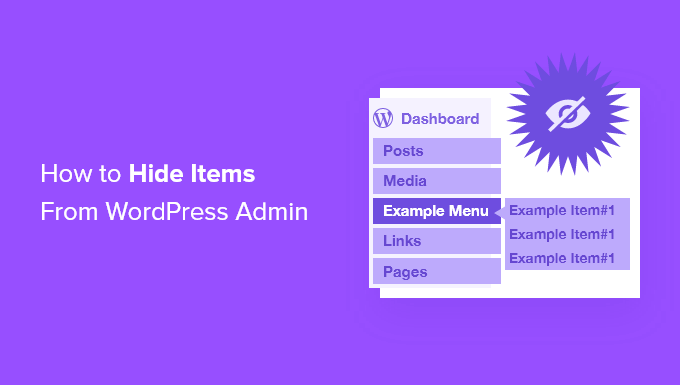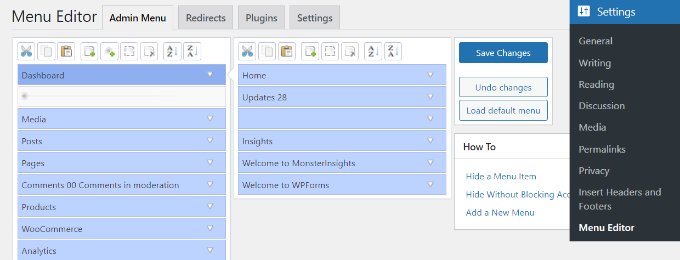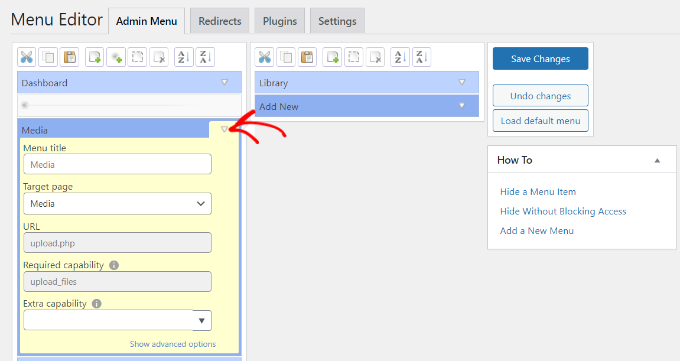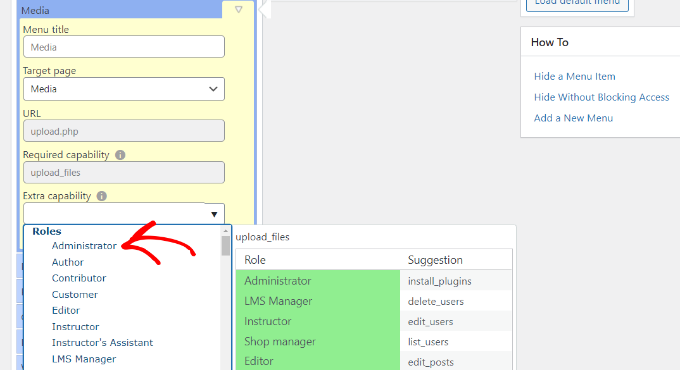Después de gestionar sitios web de WordPress durante años, hemos descubierto que el área de administración de WordPress puede saturarse con elementos de menú innecesarios. Esto es especialmente cierto cuando se está ejecutando un sitio de varios autores o la gestión de sitios web para los clientes.
Limpiar el área de administración ayuda a tu equipo a centrarse solo en las opciones esenciales que necesitan, sin el desorden de características poco utilizadas. Es una forma sencilla pero eficaz de agilizar el proceso de gestión de WordPress y mejorar la experiencia de usuario de tu equipo o tus clientes.
En este artículo, le mostraremos cómo ocultar elementos innecesarios del área de administración de WordPress, ayudándole a crear un espacio de trabajo más limpio y eficiente para usted y sus usuarios.

¿Por qué ocultar elementos del menú de administrador / administración en WordPress?
En el área de administración de WordPress, hay un montón de menús, submenús, opciones y ajustes de temas y plugins que puedes cambiar en cualquier momento. Algunos de estos elementos del menú de administración de WordPress incluyen widgets del escritorio de WordPress, área de edición de entradas, plugins, apariencia, herramientas y mucho más.
Sin embargo, la mayoría de estas opciones de menú no se utilizan a diario y acaban saturando la pantalla del administrador. Si gestionas un sitio web WordPress con varios autores o tienes clientes que visitan el área de administración, entonces es una buena práctica limpiar el panel de administrador / administración de WordPress.
Solo debe mantener los menús y opciones que sean útiles para sus autores y clientes y ocultar el resto de los submenús.
También puede desactivar elementos en función de los perfiles de los usuarios creando diferentes interfaces de administración para usuarios con diferentes perfiles y capacidades en su sitio WordPress.
Dicho esto, veamos cómo puede quitar / eliminar elementos innecesarios del menú del administrador de WordPress.
Nota: Esta guía es acerca del menú de administración / escritorio que un usuario registrado en su sitio ve cuando accede.
Si quieres personalizar los menús de navegación que ven todos los visitantes de tu sitio web, entonces deberías ver nuestra guía paso a paso sobre cómo añadir un menú de navegación en WordPress.
Tutorial en vídeo
Si prefiere instrucciones escritas, siga leyendo.
Cómo ocultar elementos específicos del menú de administración de WordPress
La forma más sencilla de ocultar menús y artículos del escritorio de administración de WordPress es usando el plugin Admin Menu Editor. Es un plugin gratuito de WordPress que te permite cambiar los títulos de los menús, URLs, iconos y mucho más.
También puede ocultar elementos del menú de la barra lateral del administrador, establecer permisos para los perfiles de usuario y arrastrar y soltar elementos del menú para organizar la barra de administración de WordPress.
En primer lugar, tendrás que instalar y activar el plugin Admin Menu Editor. Para más detalles, consulta nuestra guía sobre cómo instalar un plugin de WordPress.
Una vez activado, puedes dirigirte a Ajustes ” Editor de menús desde tu escritorio de WordPress. En esta página de ajustes, verás todos tus elementos de menú y submenú en la pestaña “Menú del administrador”.

Basta con arrastrar y soltar los elementos del menú para reorganizar su orden. También hay opciones para quitar / añadir nuevos elementos de menú.
A continuación, haz clic en la flecha hacia abajo de cualquier elemento / artículo del menú para ver más opciones. Puede cambiar el nombre del título del menú, cambiar la página de destino, etc.

Para ocultar un elemento del menú de administración a un usuario concreto, basta con hacer clic en el menú desplegable “Capacidad adicional”. A continuación, puede elegir el perfil de usuario que puede ver el elemento / artículo del menú de las opciones dadas.
Por ejemplo, supongamos que desea ocultar el menú Medios y sus submenús para todos los perfiles de usuario excepto el de administrador. Para ello, basta con hacer clic en el menú desplegable “Capacidad adicional” y elegir “Administrador” en Roles.

Cuando hayas terminado, guarda los cambios.
Ahora, el elemento del menú Medios será visible solo para el perfil Administrador y estará oculto para otros perfiles de usuario.
Si alguien sigue intentando acceder al elemento oculto del menú escribiendo la URL, verá el mensaje de error “No tiene permisos suficientes para acceder a esta página de administrador”.

Ahora puede repetir estos pasos para ocultar otros elementos del menú de administrador y plugins para diferentes usuarios.
Para más formas de personalizar tu administrador / administración de WordPress, puedes comprobar estas guías:
- Consejos vitales para proteger su área de administrador / administración de WordPress (actualizado)
- Cómo poner etiqueta blanca a su escritorio de administración de WordPress
- Cómo añadir avisos personalizados de administrador en WordPress
- Cómo proteger con contraseña el directorio de administración de WordPress (wp-admin)
- Cómo cambiar la combinación de colores del administrador / administración en WordPress (Rápido y fácil)
Esperamos que este artículo te haya ayudado a ocultar elementos innecesarios del área de administración de WordPress. Puede que también quieras comprobar nuestra selección de los mejores plugins de seguimiento y registro de actividad de WordPress y nuestra guía sobre cómo desactivar la barra de administración de WordPress.
If you liked this article, then please subscribe to our YouTube Channel for WordPress video tutorials. You can also find us on Twitter and Facebook.





Jiří Vaněk
I have been using the website every day for about a year and a half. During that time, I have already installed almost everything I need for my work, but the truth is that it now has twice as many items and practically I need maybe half of it. Is it necessary to install a plugin, or can some parts of the menu be hidden with a snippet? He would like to avoid another plugin.
WPBeginner Support
The code required in a snippet would be a bit beyond what we would recommend for beginners which is why we recommend the plugin. For concerns about using a plugin we would recommend taking a look at our article below:
https://www.wpbeginner.com/opinion/how-many-wordpress-plugins-should-you-install-on-your-site/
Admin
JAVED AKHATR NAYYER
this is good method but how can i again showed all menues please discribe
WPBeginner Support
You would want to use the load default menu button on the side to return to the default menu.
Admin
Howard Hue
Hey. Don’t use a plugin just use a conditional IF statement. There are a bunch you can use but here are a couple good ones to add to your functions or custom functions file.
If you’re savvy with WP and some light coding this is the best alternative to a plugin by far, in my opinion.
// Remove a main menu page link on admin/dash
remove_menu_page( ‘$mainmenu-sluge’ );
// Remove a main menu’s submenu link on admin/dash
remove_submenu_page( ”$mainmenu-slug”, ”$submenu-slug”);
Hope this helps.
WPBeginner Support
Thank you for sharing this, our guides are designed for beginners that don’t have coding knowledge first but for those looking for an alternative, this could be a helpful option.
Admin
Kumar
we have wordpress site, in our admin panel settings and Appearance not available, don”t why…whats the problem…
WPBeginner Support
Your user may not be an admin user for your site if you had someone else set it up for you.
Admin
Kenneth Bryan Domingo
Hi! I want to hide the tutorial tab on my menu but I can’t find it can anyone help me? I can send you pictures of it. Thanks!
WPBeginner Support
If the menu is added via a plugin then you would want to reach out to your plugin’s support and they should be able to help you with hiding it.
Admin
vincent
Is the tick displayed or hidden? Is there a suggested role setting? Specific teaching
WPBeginner Support
If it is checked/ticked then that item would be removed from that level’s view
Admin
Hurab
please guide how to disable the notification for editor. i have tried already but still can see.
Pleaseguide
WPBeginner Support
There should be the option to disable admin notices depending on the notices you no longer want to appear.
Admin
KITHO
How can I hide some menu items for only certain Administrators not all of them? Because there are admins that I don’t want to touch on any design/customizations.
Leon Lalaev
Use this function in theme function p h p file
Ron
Hi,
Any news/info/solution/… about those flags! I have just installed plugin (super cool I must say), add demo user, playing with restrictions, logged in on another machine as demo user… ok. Done this “To view your changes to the menu you need to navigate away from the Adminimize settings page.” several times…
But on the end of a day if this demo user would call me and said “I don’t see Woocommerce”… Well demo user! I see no flags on your Woo…
Good for me to add demo user. I think I said enough.
Br,
Naomi
Thank you, I have just installed and worked fine!
Sreeny
Wow !
Very useful article.
Superb !
Julie
I didn’t know this plugin, it’s amazing! Thank you so much for making me discover it, you saved my life haha
Giovanni
Hello.
After the last update 1.10.1 no longer see the flags of the things that I selected.
How can I do?
Thanks in advance.
Cliff
Thank you.
This was very helpful.
Sherry
If I have role1 and role2 and each role has their own sidebar widget. Is there a way to add a hook so that when role1 is logged in they will only see sidebar widget1 and when role2 is logged in they will only see sidebar widget2. (see and be able to edit their own widget)
Currently adminimize allows me to show or hide sidebar so there is no way to specify which sidebar widget.
Thanks
Patrick
This saved me alot! I have this annoying client that keeps on destroying a customized (hard-coded) theme by resetting the appearance theme option on purpose to keep on demanding for unnecessary revisions. Now they can only edit posts which is suppose to be what the client should only be doing. Thanks alot for this!
Thanks alot for this!
robert
i think is better to use of hack rather than using too many plugins and most of them has bug also, which allow hackers kill your website! for example here i share you some of those codes to hide admin items:
function remove_dashboard_widgets() {
global $menu,$submenu;
global $current_user;
get_currentuserinfo();
if ($current_user->ID != 1) { // only admin sees the whole thing
// $menu and $submenu will return fo all menu and submenu list in admin panel .
$menu[2] = “”; //Dashboard
$menu[5] = “”; // Posts
$menu[15] = “”; //Links
$menu[25] = “”; //Comments
$menu[65] = “”; //Plugins
unset($submenu[‘themes.php’][5]); //themes
unset($submenu[‘themes.php’][12]); //editor
}
}
add_action(‘admin_head’, ‘remove_dashboard_widgets’);
Linda
Robert, your information is interesting. But as a non-coder, I wouldn’t know where to put this little nugget. Any more info on that?
Gozie
you’re right, and I used your code, it worked well. but how did you come up with this and how can I use it for more security like disabling access to some other sections of my website. thanks.
gina
I have comments deactivated in adminimize in the menu options but it stil shows up on the admin screen for all users. I would like only admins and editors to see the comments.
Matt Rock
While the article is promising, as of this writing the plugin is compatible up to version 3.6 and hasn’t been updated in almost a year.
I currently update the functions file using a great tutorial by Justin Tadlock (http://tinyurl.com/qda95ap) but this plugin looks like it would really streamline the process.
Does anyone know of a similar plugin which is actively maintained and
compatible with the latest version of wordpress (currently 3.9)?
e-rik
While the possibilities of this plugin are very nice and extensive, It misses one giant thing: the possibility to minimize the dashboard for certain administrators. On my client’s sites I want to maintain full access on my own admin account and limit the client’s admin acount(s). Or did I miss something and is this possible?
Itay
You will need to use it in cojunction with
User Role Editor plugin.
WPBeginner Staff
No, it does not.
WPBeginner Staff
Yes it is multisite compatible. We will try to cover the scaling of multisite WordPress in some future article. Thanks for the suggestion. However, for the time being try using plugins that are well coded, come highly recommended, and are well documented.
lucky
I installed it on multisite but wanted to control these things network wide not site by site. I could see no way to do that.
ThatK1dB
This is great. i just had a client with no knowledge of WP and had to disable certain features so he didn’t blow this thing up. This plugin has helped. Also, very easy to use.
Thanks!
Jeff
I agree. Same problem. Easy to deactivate permissions, but an editor in itself does not have access to certain features which mean I need to give admin role to managers of the site. Then I “deactivate” features and me too as an admin lose the same permissions! Weird.
This plugin is undiectional – yuo can deactivate but not asctivate permissions.
Itay
You will need to use it in cojunction with
User Role Editor plugin.
aathi
is it multisite compatible ? And also can you do a post on scaling a multisite along with plugins ?it will be useful for us.We are finding it difficult to find info about wordpress multisite. Your help will be appreciated.
RW
This looks like an amazing plugin! Wow, I wonder if something this powerful adds a lot of weight and queries to the database. Does this plugin slow down editing the site?